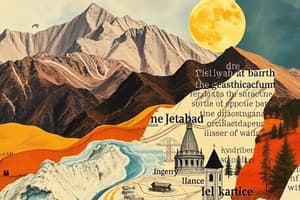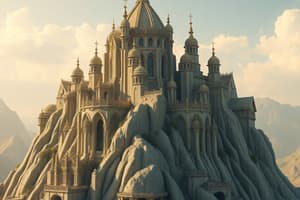Podcast
Questions and Answers
Which of the following processes is MOST associated with the transportation of weathered materials?
Which of the following processes is MOST associated with the transportation of weathered materials?
- Deposition
- Tectonic uplift
- Erosion (correct)
- Weathering
What is the primary factor that differentiates climate from weather?
What is the primary factor that differentiates climate from weather?
- Time scale (correct)
- Humidity levels
- Geographic location
- Air pressure
Which component of the water cycle involves the change of water from a liquid to a gaseous state?
Which component of the water cycle involves the change of water from a liquid to a gaseous state?
- Evaporation (correct)
- Condensation
- Runoff
- Precipitation
Which of the following factors MOST directly influences the distribution of plant and animal species in a given area?
Which of the following factors MOST directly influences the distribution of plant and animal species in a given area?
Which of these is a key component that distinguishes soil from simple mineral deposits?
Which of these is a key component that distinguishes soil from simple mineral deposits?
Which of the following processes is MOST responsible for shaping coastal landforms such as beaches and cliffs?
Which of the following processes is MOST responsible for shaping coastal landforms such as beaches and cliffs?
What is the MOST significant impact of accelerated glacial melting on coastal regions?
What is the MOST significant impact of accelerated glacial melting on coastal regions?
Which of the following concepts is MOST closely associated with balancing human needs and environmental protection for future generations?
Which of the following concepts is MOST closely associated with balancing human needs and environmental protection for future generations?
The study of landforms and the processes that shape them is known as:
The study of landforms and the processes that shape them is known as:
Which of the following is NOT considered a primary factor influencing climate patterns?
Which of the following is NOT considered a primary factor influencing climate patterns?
Which of these describes the continuous movement of water on, above, and below the surface of the Earth?
Which of these describes the continuous movement of water on, above, and below the surface of the Earth?
A community of living organisms interacting with each other and their physical environment is known as:
A community of living organisms interacting with each other and their physical environment is known as:
The composition of soil includes which combination of components?
The composition of soil includes which combination of components?
Which of the following is a significant environmental issue associated with soil erosion?
Which of the following is a significant environmental issue associated with soil erosion?
The dynamic interface between the ocean and the land is the focus of which area of physical geography?
The dynamic interface between the ocean and the land is the focus of which area of physical geography?
Large masses of ice that flow under their own weight are known as:
Large masses of ice that flow under their own weight are known as:
What is the primary focus of environmental geography?
What is the primary focus of environmental geography?
In the context of geomorphology, what process directly follows weathering?
In the context of geomorphology, what process directly follows weathering?
Which of the following climate zones is characterized by high temperatures and abundant rainfall throughout the year?
Which of the following climate zones is characterized by high temperatures and abundant rainfall throughout the year?
Which aspect of physical geography is MOST concerned with the study of freshwater resources?
Which aspect of physical geography is MOST concerned with the study of freshwater resources?
Flashcards
What is Geography?
What is Geography?
Study of Earth's surface including physical features, climate, population, and resources.
What is Physical Geography?
What is Physical Geography?
Focuses on the natural environment and Earth's physical features and processes.
What is Geomorphology?
What is Geomorphology?
The study of landforms and the processes that shape them.
What is Weathering?
What is Weathering?
Signup and view all the flashcards
What is Erosion?
What is Erosion?
Signup and view all the flashcards
What is Deposition?
What is Deposition?
Signup and view all the flashcards
What is Climatology?
What is Climatology?
Signup and view all the flashcards
What is Climate Change?
What is Climate Change?
Signup and view all the flashcards
What is Hydrology?
What is Hydrology?
Signup and view all the flashcards
What is the Water Cycle?
What is the Water Cycle?
Signup and view all the flashcards
What is Biogeography?
What is Biogeography?
Signup and view all the flashcards
What are Ecosystems?
What are Ecosystems?
Signup and view all the flashcards
What is Soils Geography?
What is Soils Geography?
Signup and view all the flashcards
What is Coastal Geography?
What is Coastal Geography?
Signup and view all the flashcards
What is Glaciology?
What is Glaciology?
Signup and view all the flashcards
What are Glaciers?
What are Glaciers?
Signup and view all the flashcards
What is Environmental Geography?
What is Environmental Geography?
Signup and view all the flashcards
What is Sustainable Development?
What is Sustainable Development?
Signup and view all the flashcards
Study Notes
- Geography is the study of the Earth's surface, including its physical features, climate, population, and resources
- It examines the spatial relationships between people and the environment
Physical Geography
- Physical geography focuses on the natural environment
- It studies the Earth's physical features and processes
Geomorphology
- Geomorphology is the study of landforms and the processes that shape them
- It includes the study of mountains, valleys, plains, and coastlines
- Weathering, erosion, and deposition are key processes in geomorphology
- Weathering breaks down rocks into smaller particles
- Erosion transports these particles away
- Deposition occurs when the particles settle in a new location
- Tectonic forces, such as plate movement, also play a role in shaping landforms
Climatology
- Climatology is the study of climate, including temperature, precipitation, and wind patterns
- Climate is the long-term average of weather conditions in a particular region
- Factors influencing climate include latitude, altitude, and proximity to oceans
- Different climate zones include tropical, temperate, and polar climates
- Climate change refers to long-term shifts in temperature and weather patterns
Hydrology
- Hydrology is the study of water on Earth
- It includes the study of rivers, lakes, groundwater, and glaciers
- The water cycle describes the continuous movement of water between the Earth's surface, atmosphere, and subsurface
- Processes in the water cycle include evaporation, condensation, precipitation, and runoff
- Water resources are essential for human activities, including agriculture, industry, and domestic use
Biogeography
- Biogeography is the study of the distribution of plants and animals
- It examines the factors that influence the distribution of species, such as climate, soil, and topography
- Ecosystems are communities of living organisms and their physical environment
- Different biomes, such as forests, grasslands, and deserts, are characterized by distinct plant and animal communities
- Human activities, such as deforestation and habitat destruction, can have a significant impact on biogeography
Soils Geography
- Soils geography studies the distribution and properties of soils on Earth
- Soil is a mixture of minerals, organic matter, water, and air
- Soil formation is influenced by factors such as climate, parent material, topography, and organisms
- Different soil types, such as sandy soils, clay soils, and loamy soils, have different properties and support different types of vegetation
- Soil erosion is a major environmental problem that can lead to land degradation and reduced agricultural productivity
Coastal Geography
- Coastal geography examines the dynamic interface between the ocean and the land
- It studies coastal landforms, such as beaches, cliffs, and estuaries
- Coastal processes, such as waves, tides, and currents, shape coastal environments
- Sea level rise is a significant threat to coastal communities
- Coastal management strategies aim to protect coastal resources and reduce the impacts of coastal hazards
Glaciology
- Glaciology is the study of glaciers and ice sheets
- Glaciers are large masses of ice that flow under their own weight
- Glaciers shape the landscape through erosion and deposition
- Ice sheets are vast expanses of ice that cover large areas of land
- Glacial meltwater is an important source of freshwater for many regions
- Climate change is causing glaciers and ice sheets to melt at an accelerated rate, contributing to sea level rise
Environmental Geography
- Environmental geography examines the interactions between humans and the natural environment
- It studies the impacts of human activities on the environment, such as pollution, deforestation, and climate change
- It also explores the ways in which the environment affects human societies
- Sustainable development aims to meet the needs of the present without compromising the ability of future generations to meet their own needs
- Conservation and resource management are key strategies for protecting the environment and ensuring the long-term availability of resources
Studying That Suits You
Use AI to generate personalized quizzes and flashcards to suit your learning preferences.




